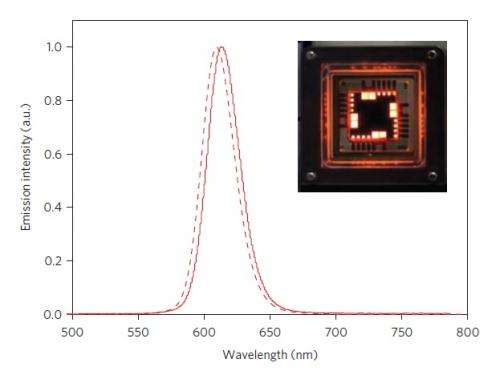May 14, 2013 feature
Quantum dot LED approaches theoretical maximum efficiency

(Phys.org) —Quantum dot LEDs (QLEDs) are a promising technology for creating large-area displays that could have applications for TVs, cell phones, and digital cameras. So far, however, the highest efficiencies of QLEDs have fallen short of those of organic LEDs (OLEDs), another large-area LED technology. Now in a new study, researchers have developed a new type of QLED with an efficiency and luminance that are the highest reported to date and comparable to state-of-the-art phosphorescent OLEDs. The new QLED's external quantum efficiency of 18% more than doubles the current highest value of which the researchers are aware, which is 8%. The efficiency is also close to the theoretical maximum for any planar thin-film LED, which is 20%.
The work was performed by researchers Benjamin S. Mashford, et al., at QD Vision Incorporated in Lexington, Massachusetts, along with researchers at MIT. QD Vision is a lighting and display company whose products are available today in Sony's Triluminos TVs. Their paper is published in a recent issue of Nature Photonics.
While QLEDs and OLEDs each have their own unique advantages, QLEDs are especially appealing for their narrow bandwidth and simple color tunability, since changing the size of a quantum dot changes its emission wavelength. QLEDs, which often contain both organic and inorganic materials, may also have longer lifetimes than OLEDs, which are based on organic materials.
A typical QLED consists of three layers: one inner layer of quantum dots, one outer layer that transports electrons, and one outer layer that transports holes. When an electric field is applied to the outer layers, the electrons and holes move into the quantum dot layer, where they are captured by quantum dots and recombine. The recombination of one electron and one hole inside a quantum dot results in the emission of one photon.
As the researchers explain in their study, a key requirement for achieving QLEDs with very high efficiencies is to have quantum dots that have a high quantum yield for electroluminescence and a device structure that is optimized for efficient charge injection.
The researchers addressed these requirements by using a layer of 6-nm cadmium-selenide quantum dots and an electron transport layer made of ZnO nanocrystals. The researchers fabricated four different versions of the QLED, each having a different quantum dot film thickness (15, 30, 45, or 60 nm).
The experiments revealed that even small variations in the quantum dot film thickness lead to a dramatic variation in QLED performance. The QLED with the 45-nm-thick film of quantum dots achieved the highest maximum external quantum efficiency of 18%, making it the highest-efficiency red LED ever made using a solution-processed emitter layer. The QLEDs also operated at low voltages (1.5 V) and with high brightness.
As the researchers explain, changing the quantum dot film thickness changes the distance between the quantum dots and the charge transport layers; a thinner quantum dot film means a larger fraction of quantum dots are in electrical contact with the outer layers.
"Devices have been tried in the literature that range from very thick to very thin (monolayer) layers of QDs, but it has remained very elusive to say what is 'the best' thickness to use," coauthor Seth Coe-Sullivan, co-founder and Chief Technology Officer of QD Vision, told Phys.org. "It isn't surprising that the performance was so dependent on thickness, but I would say that the optimum answer was surprising to me."
The researchers think that the observed dependence of QLED performance on the layer thickness can be explained in more detail by recent findings on quantum dot research. Their proposed explanation involves an ultrafast charge transfer, in which quantum dots are rapidly returned to a neutral charge state, which leads to increased stability. In addition, a good alignment of energy levels between the quantum dots and the charge-injection layers also assists in efficient charge transfer.
Overall, these improvements are possible due to scientists' growing knowledge of quantum dot photophysics, and the researchers expect QLED technology to continue to grow as this knowledge increases.
"The biggest challenge facing QLEDs, especially after this efficiency milestone, is in the reliability or lifetime of the devices," Coe-Sullivan said. "While current devices do live long enough for some niche applications, they are not generally sufficient for mainstream market introduction.
"QD Vision will continue to push performance and manufacturability of QLEDs, both for visible and infrared applications of the technology."
More information: Benjamin S. Mashford, et al. "High-efficiency quantum-dot light-emitting devices with enhanced charge injection." Nature Photonics. DOI: 10.1038/NPHOTON.2013.70
Journal information: Nature Photonics
© 2013 Phys.org. All rights reserved.




















